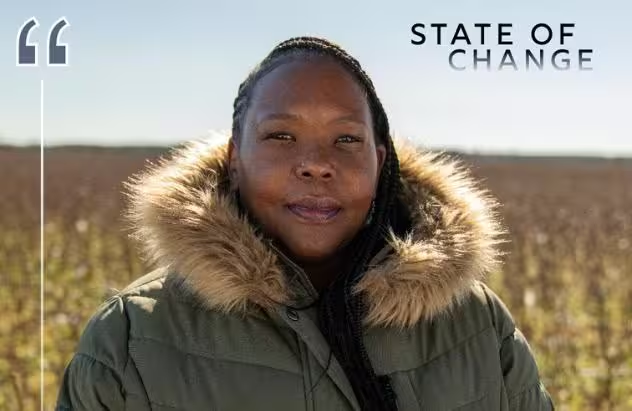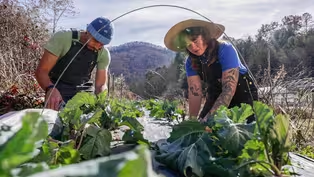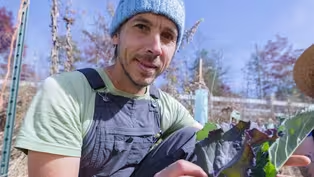
EnerWealth: Growing Solar Options in Rural Communities
Clip: Special | 8m 12sVideo has Closed Captions
EnerWealth works with rural farmers in NC to ensure they get a piece of the solar pie.
Can farming and solar-energy production coexist in the South? Learn how EnerWealth Solutions and Roanoke Cooperative work with farmers and landowners in rural North Carolina to harness the power of renewable solar energy alongside agricultural production as well as help ensure that revenue is shared equitably with the community.
Problems playing video? | Closed Captioning Feedback
Problems playing video? | Closed Captioning Feedback
State of Change is a local public television program presented by PBS NC
State of Change is part of the Pulitzer Center’s Connected Coastlines reporting initiative. For more information, go to https://pulitzercenter.org/connected-coastlines.

EnerWealth: Growing Solar Options in Rural Communities
Clip: Special | 8m 12sVideo has Closed Captions
Can farming and solar-energy production coexist in the South? Learn how EnerWealth Solutions and Roanoke Cooperative work with farmers and landowners in rural North Carolina to harness the power of renewable solar energy alongside agricultural production as well as help ensure that revenue is shared equitably with the community.
Problems playing video? | Closed Captioning Feedback
How to Watch State of Change
State of Change is available to stream on pbs.org and the free PBS App, available on iPhone, Apple TV, Android TV, Android smartphones, Amazon Fire TV, Amazon Fire Tablet, Roku, Samsung Smart TV, and Vizio.

Explore More from State of Change
Hear from North Carolinians about climate change effects & innovative solutions across the state.[gentle music] - [Ajulo Othow] North Carolina's been leading the country for years in our solar generation, which is wonderful.
There are gaps though, and there are ways to improve.
There's the potential for broadening of the benefits economically for communities and people who have been historically disadvantaged as a part of this energy transition.
EnerWealth, in many ways, the name kind of embodies what our mission is all about.
We started because I realized after spending about two decades in rural development, that solar energy investments were going to be the new source of revenue coming into rural communities.
And I wanted to be sure that that investment would do more than what it had been doing.
I work with smaller acreage landowners on what's called distributed size solar generation projects.
So these are smaller sites.
They're less than five megawatts, typically less than 30 acres, and in this case, they're actually less than five acres.
And the reason why we build these smaller systems is, one, we're able to capture more value from the solar energy by pairing it with battery storage.
And two, because we're trying to demonstrate a way of building solar projects that is co-located alongside agricultural production that's in harmony with the surrounding community and the neighborhood as a model for the way that solar can be deployed across the rural south, across the country.
Part of the EnerWealth story is helping rural families, especially families with smaller acreage, minority landowners, small farmers, to hold onto their land from one generation to the next.
Who is this beautiful woman here?
- That's Marion Mitchell.
That's me.
- That's you with your two children?
- My two children, Derek and Lavonda.
- And these pictures are a little older.
- Yes, they are.
- And so I don't, I wanna be very careful with them.
- Uh huh, yeah.
This is my mother.
- Okay.
- Mary Fannie Boone.
This is our father, Bryant J. Boone, right there.
- [Ajulo] Okay.
Oh, and I see right there it says BJB on the trailer.
- Uh huh.
Yeah.
My grandfather was the one that got it started because he had bought the land.
And like I say, he had, my grandfather had oodles and oodles of land.
But when he died, he had four children, three boys and one girl, and he made sure each one of 'em had a farm of their own.
And so that's how this farm got here that my daddy took over.
This was his farm, and he farmed it until he was disabled, 'til he farmed it again, and then he start leasing it out.
And that's how we've been going ever since.
- We know that land is a source of wealth for people.
The question is how are they able to maintain it from one generation to the next?
The two landowners that we worked with with our pilot projects are actually African American landowners.
And the history of land retention in the African American community is actually a sad story.
Many African American landowners have lost their land, millions and millions of acres over generations, which is amounting to billions of dollars worth of wealth that's been stripped away in one way or the other from those landowners.
The beauty of our project is that landowners are able to continue to cultivate their land.
It works well for farmers because this is another way to diversify their revenue streams, to diversify their income.
We do want folks to have the flexibility, alongside the solar production, to be able to farm or use that land for recreational purposes or any other purpose that the family might want to use it for, and both can be done.
We are proving this model to show that it's accessible for rural electric cooperatives to have both solar and storage, and that it serves the grid as well as their consumers.
There are 900 rural electric cooperatives across the country.
Many of them are in the southeast.
- Typically, areas that are served by electric cooperatives are gonna be very rural, very agrarian, which is the case here in Northeastern North Carolina.
A lot of farmland and a lot of scattered areas, particularly when it comes to the investments that have been made to provide the service.
Projects like this one really bring a lot of layers of benefit to our mill owners.
So this is a solar plus battery storage installation.
It's not a micro grid that's serving a home per se, and it's powering the grid itself when the solar arrays are producing.
And the benefit of the batteries actually brings some flexibility for us as electric cooperatives because we are buying power.
We do not own any generation in electric cooperatives.
And so our needs during specific times of the month call for us to be able to limit our use of the electrical grid.
And that's where the batteries come into play.
We're able to reduce costs by making sure that we're relieving ourselves of some more expensive cost during peak periods on the wholesale power grid.
But another layer to this is the work that we're able to do with some of our landowners who are participating in another program that we have here at Roanoke that's called the Sustainable Forestry and Land Retention Program.
These individuals now have an opportunity to bring levels of wealth creation to their families somewhere in the range of about 30 years, 30 to 40 years, which can traverse several generations.
So we're talking about wealth creation, we're also talking about job opportunities, community and economic development.
Tie it back to how we make maximum use of the electrical grid.
It is very important for us to make sure that everyone is able to participate.
- So about how old do you think this house is?
- I know it's every bit a hundred years old.
- Yeah, at least a hundred years old.
- Uh huh, yeah, it is a hundred years old.
See that, my little garden, my little collards.
- I see 'em.
- There's one type of salad, there's another type of salad, and there's another type of salad over there.
And this is collards.
These are collards.
My mother and father, they worked very hard to keep this land and get the land started.
We're not gonna be selling this land because it stay in the generation because my mother and father started this farm.
Take care of what you already have.
- They don't make new land.
- Mm-mm.
No, they sure don't.
Mm-mm.
[gentle music] - [Ajulo] One of the most interesting features of our energy transition is that there's actually a systemic change happening around ownership of energy production.
We need to have agricultural production, and we need to have that alongside clean energy, renewable energy production, and the two can actually work together.
We've already seen that we believe in this technology by being second in the nation.
Our utility has been benefiting from it for more than a decade now.
And so it's time for everyday people to also be able to benefit from the technology too.
And that's really exciting.
[gentle music] ♪
Altapass Orchard: Conserving Land for Climate Resiliency
Video has Closed Captions
Clip: Special | 7m 52s | Land conservation is not a “one size fits all” solution. This orchard shows us one way. (7m 52s)
Preview | State of Change: Seeds of Hope
Video has Closed Captions
Preview: Special | 30s | Meet the North Carolinians who are adapting to climate change in new and inspiring ways. (30s)
Utopian Seed Project: Rethinking Our Food System
Video has Closed Captions
Clip: Special | 10m 17s | The Utopian Seed Project works to build NC’s climate resiliency through crop diversity. (10m 17s)
Providing Support for PBS.org
Learn Moreabout PBS online sponsorship
- Science and Nature

Explore scientific discoveries on television's most acclaimed science documentary series.

- Science and Nature

Capturing the splendor of the natural world, from the African plains to the Antarctic ice.












Support for PBS provided by:
State of Change is a local public television program presented by PBS NC
State of Change is part of the Pulitzer Center’s Connected Coastlines reporting initiative. For more information, go to https://pulitzercenter.org/connected-coastlines.


